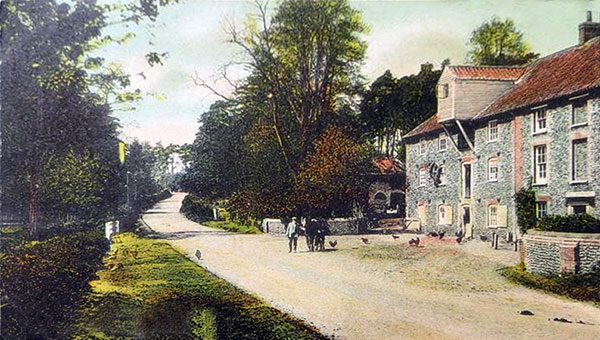 |
|
c.1900
|
|
Hempstead Mill
River Glaven |
what3words location - ///bowls.headlines.actors |
 |
|
c.1900
|
Hempstead watermill
and the adjoining mill house are built of local flint and brick under a
Norfolk pantiled roof and are Grade II listed. The present building was built by Richard John Gurney
in 1830 and at that time was known as Holt Mill, undoubtably because the mill is actually within the parish of Holt. The original watercourse,
along which the parish boundary still runs, was moved northwestwards some 40 yards
slightly up the hill towards Holt in order to better accommodate the mill machinery.
The Glaven, which used to be called Hempstead Beck, was effectively dammed
by the mill thereby forming the large lake to supply the mill and that is still above the mill
today. At the time locals used to say, "Mr. Gurney, he built a barn where there weren't enough corn to put in it and a mill where there weren't enough water to turn the wheel." |
C18. Flint (Quaternary) and chert with red brick dressings. Hipped pantile roof. Three storeys. Brick dentil eaves. House and mill in one continuous range. House of three bays. Central doorway with doorcase and six panelled door. Sashes with flat rubbed arches. Blocked openings over doorway. Chimney stack in line with entrance door. Mill of four bays. Casements and fixed lights with glazing bars. Segmental brick arches over openings. Two doors at first floor level. Second floor window openings blocked. Small brick chimney on ridge line at party wall between house and mill. Water wheel replaced by Turbine Machinery removed. English Heritage |
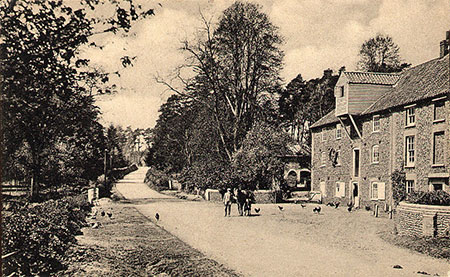 |
|
Original of above hand coloured photo - c.1900 |
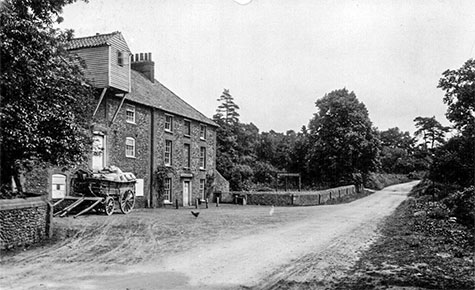 |
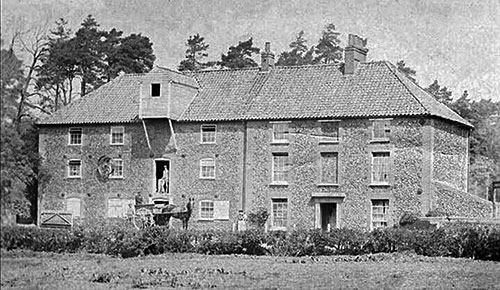 |
|
c.1902 |
c.1905 |
|
The River Glaven
had 16 mills throughout its length at the time of Domesday. |
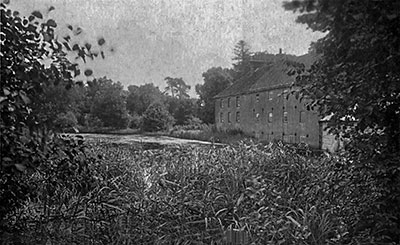 |
|
Mill dam c.1921 |
|
In about 1905 the wheel was removed and replaced by a turbine, this being a more efficient way of using the limited amount of available water. The wheel house was split into two sections lengthways by a new wall, each section with its own exit arch and then another wall was built across the section nearer to the mill to provide a sluice control for the turbine. |
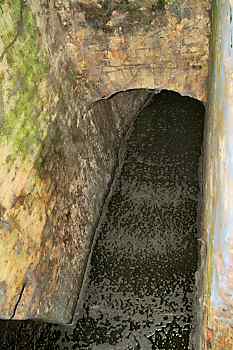 |
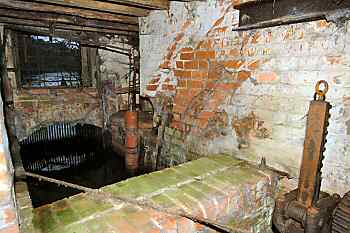 |
|
Turbine
tailrace 6th January 2004
|
Marks
on the wall left by the wheel 6th January 2004 |
|
At the beginning of 20th century, when the turbine was fitted, there were 5 sources of water - mill dam, upper pond (swept away in the 1912 floods) Horsepit Pond, Old Decoy (Selbrigg Pond) and New Decoy. |
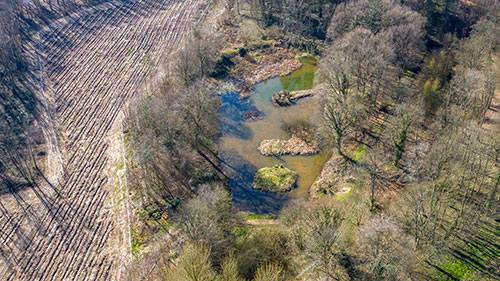 |
Horsepit pond - 22nd March 2020 |
Horsepit was originally the farm horse pond for Red House Farm, fed by runoff water from the farm and its buildings but the Gurney's added a sluice in order to supplement the mill dam. The mill could only run at full power for a maximum of 5 hours a day without emptying the dam above. Thus in later times a traction engine ran the mill via a pulley wheel on the outside of the building (see below). There were two pairs of stones by W. Tinsley of Ipswich, often only one would be worked due to lack of water. Maximum output was 4 coombs per hour. |
Selbrigg Pond was dug by hand around 1810 as a header reserve for Hempstead Mill. The mill was suffering from insufficient water despite 4 other smaller ponds having been made between the mill and Selbrigg Pond. The Tithe map of 1840 shows a pond around 9 acres in size with streams from Bodham and Baconsthorpe entering the pond. Indeed the pond stretched back to 'Selbrigg Road' In Lower Bodham. The parish boundary between Hempstead and Bodham runs through the pond, presumably along the original line of the streams. Subsequently to the original pond being dug, a duck decoy was incorporated - a funnel shaped area that was netted as a way of catching ducks. Furthermore, a boat house was subsequently built mid-way along the Northern bank, little now remains. Francis Fielden, Selbrigg |
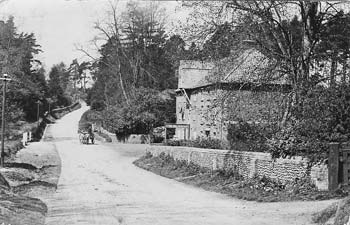 |
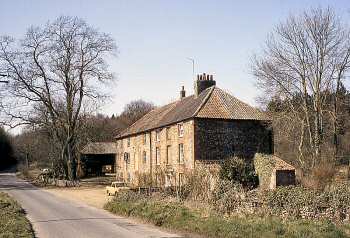 |
|
J.
Tuck Coal Merchant sign 1907
|
14th
April 1983 |
|
John Tuck was both a miller and a coal merchant. He took over from George Bird and was running both businesses from the mill when the above left picture was taken in 1907. |
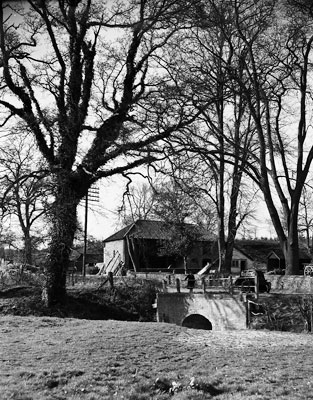 |
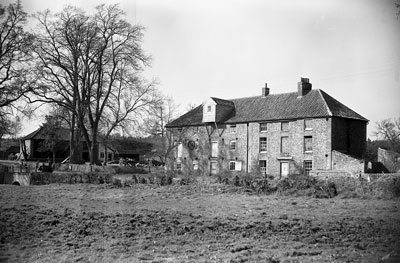 |
c.1952 |
|
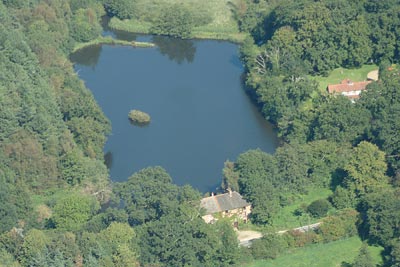 |
4th September 2004 |
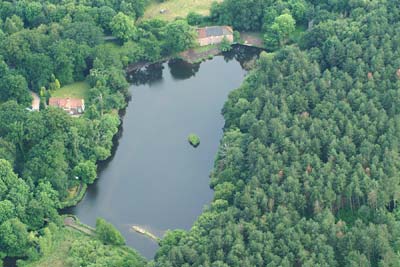 |
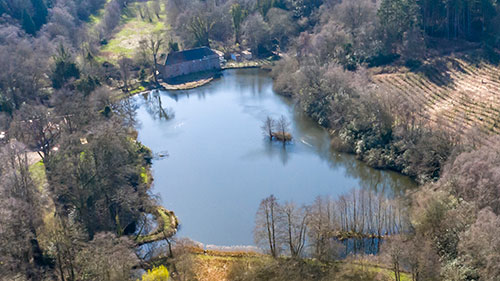 |
|
Rear of mill 30th June 2004 |
22nd March 2020 |
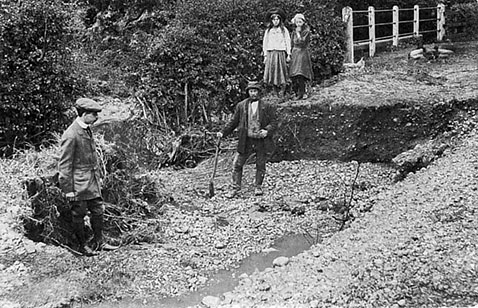 |
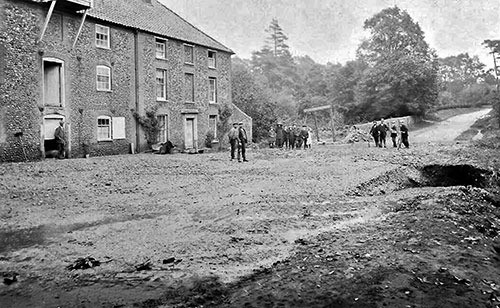 |
Aftermath of the Great Flood of Monday 26th and Tuesday 27th August 1912 |
|
|
The road on
the Holt side of the mill was washed away to a depth of several feet on
Monday 26th August 1912. On the left hand photo above, Reggie Preston is inspecting the damage with his sister Mary (on the left)
and friend Miss Gooch in the background. The name of the workman is not
known. |
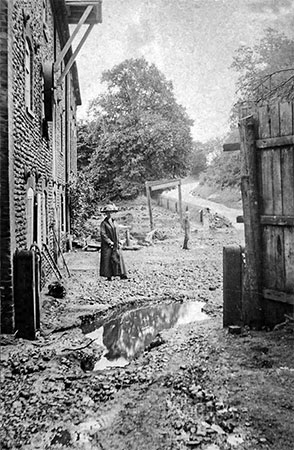 |
27th August 1912 |
The Great Flood as it became known, occurred after almost 30 hours of gales and continuous rain from 4.00am on 26th until 9.00am on Tuesday 27th August 1912. Around 8 inches of rain fell. |
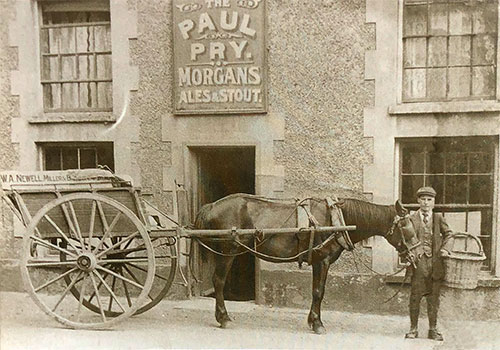 |
Reg Crowe, bakers' boy delivering in Holt - 1917 |
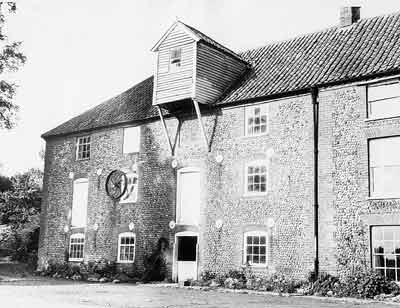 |
|
c.1968
|
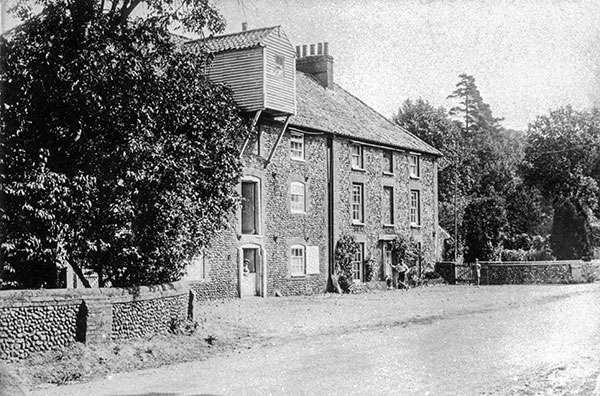 |
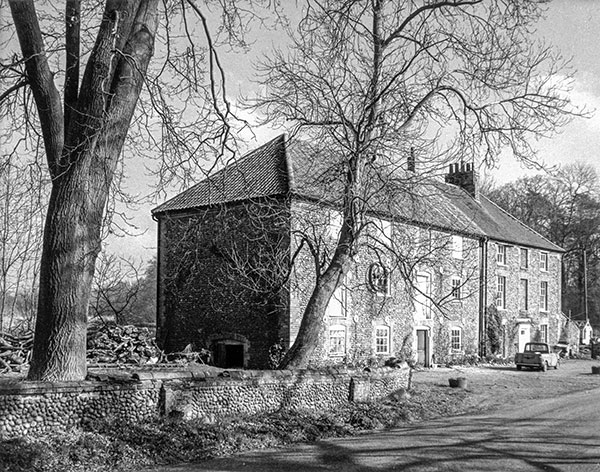 |
c.1925 |
c.1974 |
|
Prior to moving to Hempstead Mill in 1912, Mrs. Newell was living at the Mill Cottages. When required, the miller at Hempstead would carry a large bag of flour down through the woods to where Frank lived. He had a resting post on the side of the track about half way down. |
|
In 1911 a bakery
was built within the complex of cartsheds, haylofts, stables, pig sties
and cowsheds. The oven built by T. Collins & Co. of Bristol, was coke
fired and the boiler also heated the contents of a twenty gallon water
tank above it that then used the heat of from hot water pipes to regulate
the oven temperature. Coke was brought in from Holt gasworks or by train
to Holt from Sheffield and then horse and cart to the mill. In those days
transport cost exceeded the material cost. |
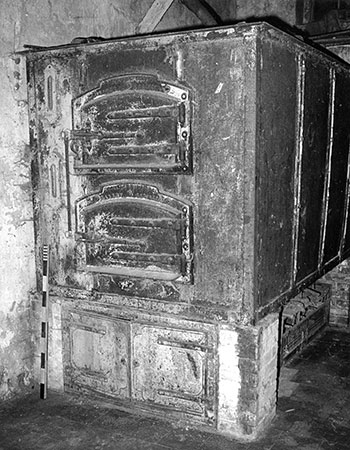 |
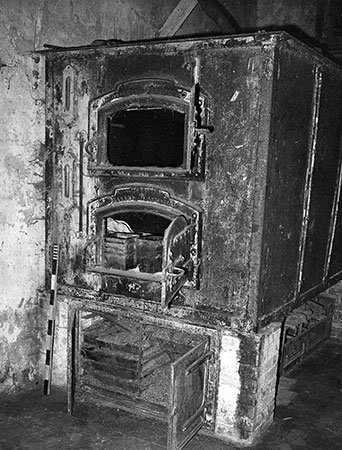 |
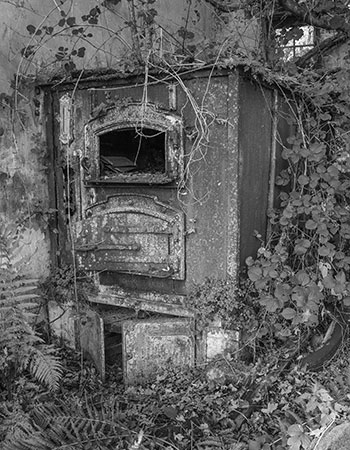 |
|
Bread
oven c.1974
|
Bread oven 12th July 1981 |
Bread oven 18th November 2021 |
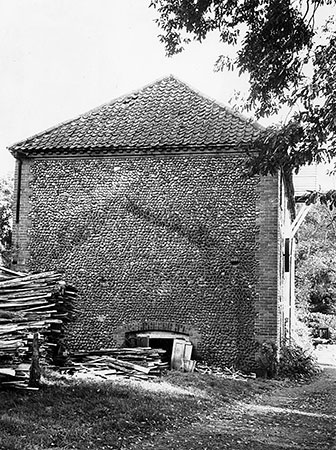 |
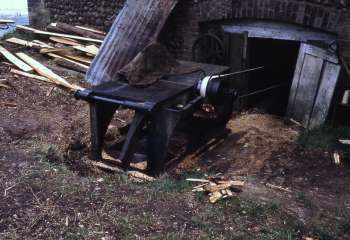 |
|
West gable end with saw pit, showing what appear to be marks of a removed extension - c.1968
|
The
turbine powered circular saw May 1967 |
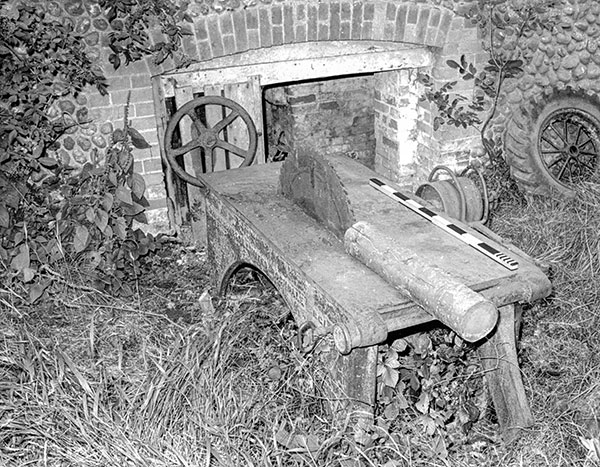 |
Saw bench c.1974 |
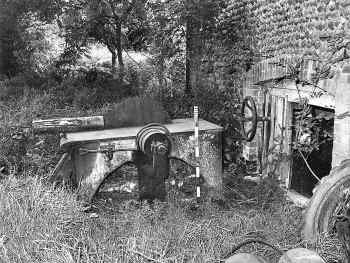 |
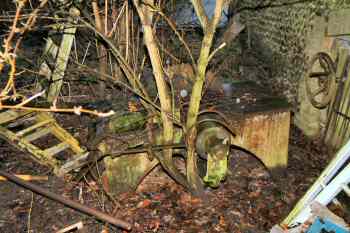 |
|
The turbine powered circular saw - 12th July 1981 |
The turbine powered circular saw - January 2004 |
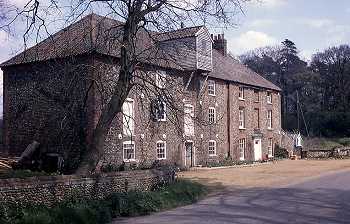 |
May 1967 |
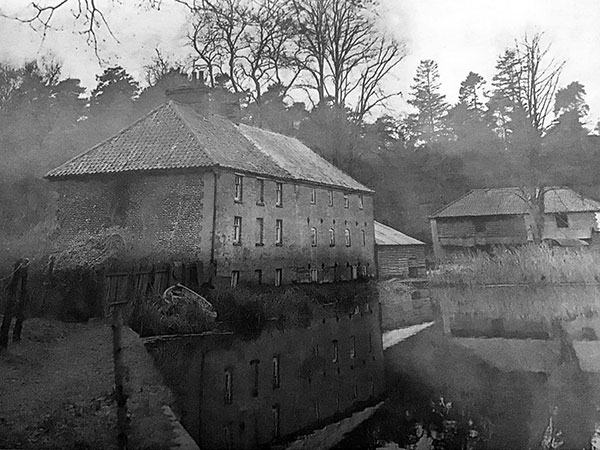 |
Mill rear August 1954 |
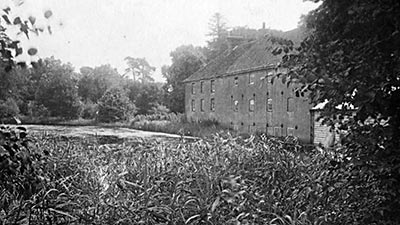 |
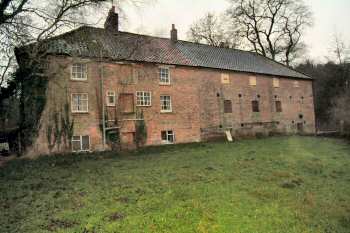 |
|
Mill rear 1921 |
Mil rear January 2004 |
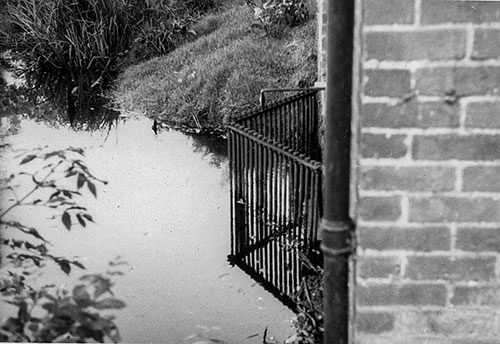 |
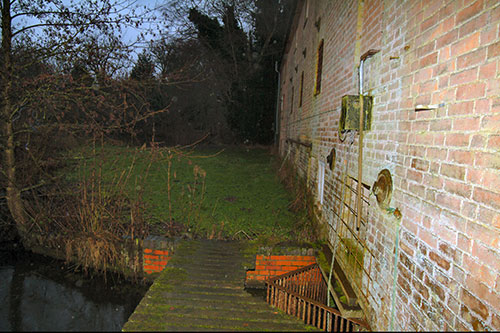 |
Weed grid - c.1968 |
Weed grid - 6th January 2004 |
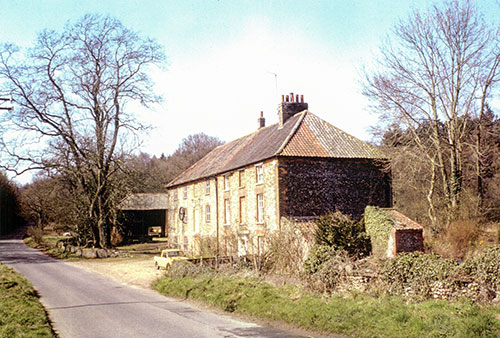 |
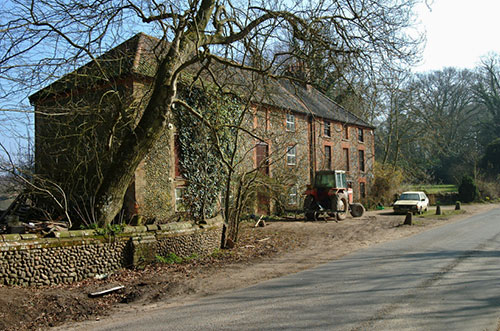 |
c.1990 |
Frontage 16th March 2003 |
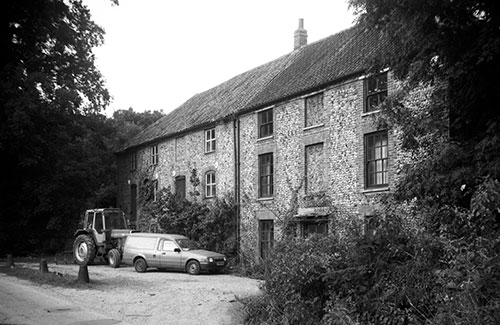 |
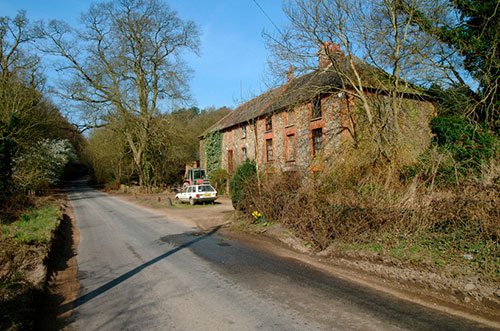 |
28th September 1997 |
16th March 2003 |
|
The turbine
also ran a circular saw blade set in a steel bench made by Robinson
& Son Ltd of Rochdale. It was used to cut timber for the Gurney Estate.
The shed that sheltered the bench has long disappeared. |
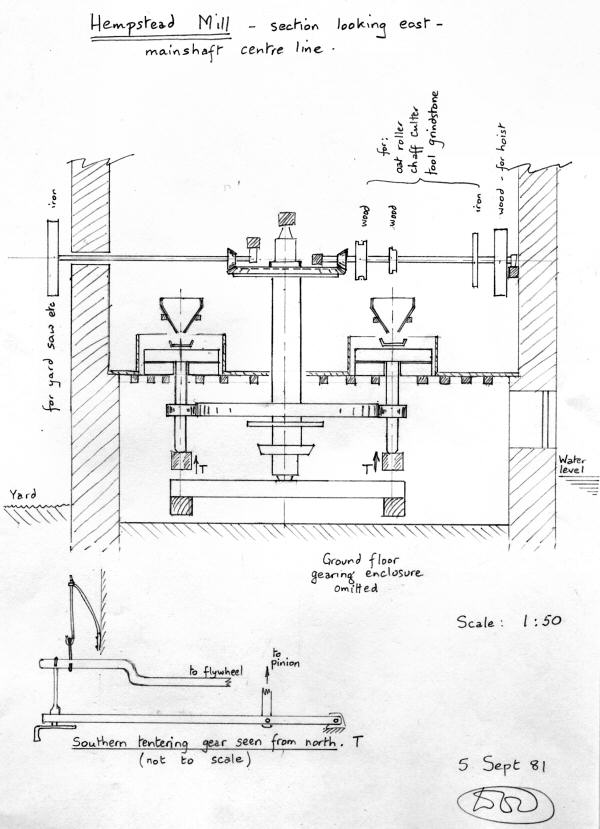 |
|
Surveyed and drawn by David Durst - 5th September 1981 |
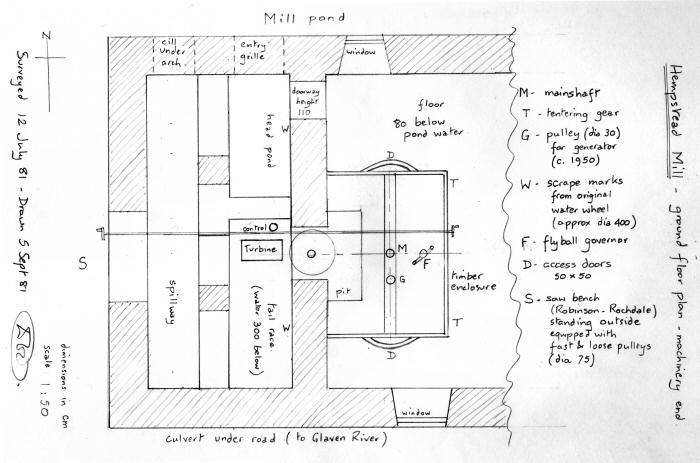 |
|
Surveyed and drawn by David Durst - 5th September 1981 |
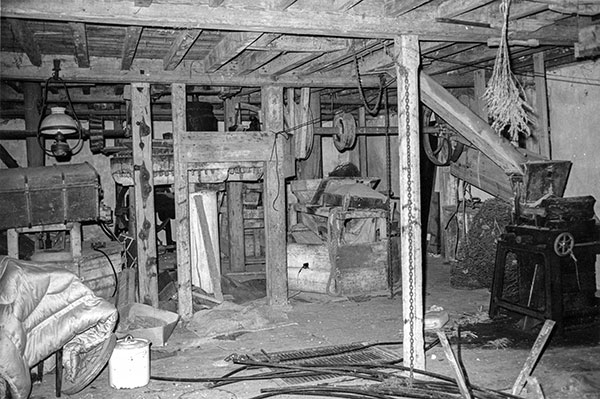 |
Stone floor - c.1974 |
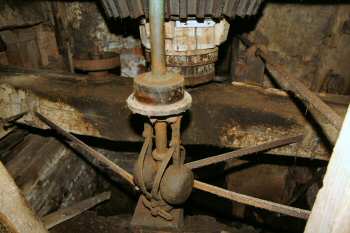 |
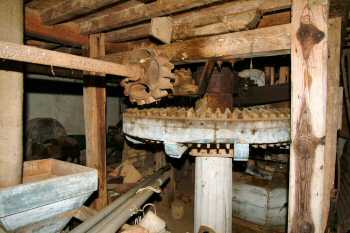 |
|
Governor
for the stone tentering gear January 2004
|
Driveshaft,
crownwheel and tuns 6th January 2004 |
 |
|
Drive
pulley
|
The right hand
photo above shows the drive shaft and gear which meshed into the crownwheel
that was driven from the pulley on the outside of the mill in times of water
shortage, when a traction engine would provide a belt drive. |
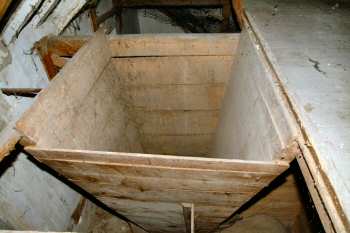 |
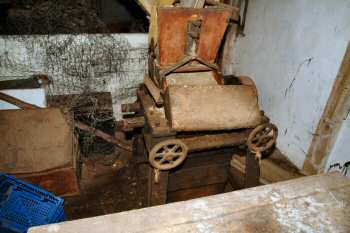 |
|
Grain hopper feeding the stones 6th January 2004 |
Oatcrusher 6th January 2004 |
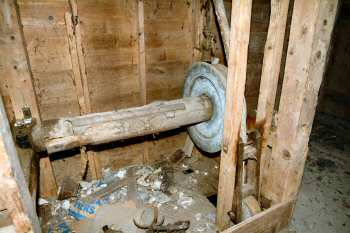 |
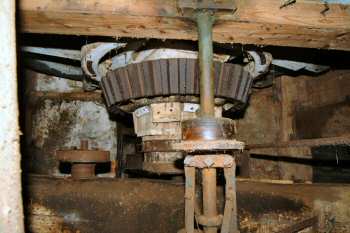 |
|
Sackhoist pulley and shaft 6th January 2004 |
Redundant wallower 6th January 2004 |
|
The Newell
brothers (Donald, Frank and William) rented the mill from the Gurneys
in 1912. It only came with one field but after one year they were allowed
to rent two more fields provided they took the bad fields along with the
good fields. |
|
By 1920 Donald's
bakery at the mill was supplying much of the locality. As a boy, John
Clarke started work at the mill by feeding the livestock going on to become
master baker. When the demand for bread was high he would often work for
30 hours without sleep. Having undertaken the morning baking starting
at 4.00 a.m., he would return in the afternoon. "I
suppose looking back, I worked long hours but one didn't think about it
in those days. In my spare time I was the village barber." |
|
Ledgers written between 1915 and 1929 indicate that some 90% of all sales related to crushing or grinding corn brought in by customers and from the sale of the resulting bran. Some flour was produced but mostly it was animal feed from oats, barley, wheat and maize. On occasions linseed, peas and beans were also processed. |
|
Prices 1839-1841: |
||||||
| Wheat
- Barley - Oats - |
7s
3s 2s |
0¼d
11½d 9d |
per
bushel per bushel per bushel |
|||
At the beginning of the century there were five immediately available supplies of water to the (Mill, the existing mill pool, the upper mill pool swept away in the 1912 floods, the “Old Decoy'' (now Selbrigg Pond), the ''New Decoy', and Horsepit Pond. There was direct access close to the Glaven from the Mill House to all of these. Each of these stores of water had its own sluice gate. As with all water-mills the business of milling decreased and all that was left was the continuing sale of animal feed-stuffs, This continued to the late 1960s. However, a circular saw had been installed and this was still being occasionally run by water power in the early seventies. In 1965, when the executors of Mr George Knight sold much of his Hempstead property, they were in something of a predicament as to how best to maximise their returns in regard to Mill_Farm Hempstead which was a tenanted farming property with, presumably, no chance of vacant possession and yet every likelihood of involving expense to the Landlord in the maintenance of the Mill. Mr George Knight's executors were in the course of selling Green_Farm to the Harmer family, who had expressed interest in all the adjoining land also being offered for sale. Seemingly the executors entered into an asset stripping enterprise by selling off separately the two cottages, together with the millpond and such of the adjoining land as was not subject to the agricultural tenancy. They maximised value by selling the millpond with the cottages - even the ground up to the north wall of the Mill House itself - and the sluiceways under the mill so that the owners of the Mill Cottages (Hawksmere) could control the levels of their millpond. Hempstead, A Norfolk Village - Robin Carver - 2000 |
The Mill |
All features of the wood are known to me |
Hempstead Mill Autobiography |
Once I had learnt to ride my bike Hempstead mill was a popular destination from school. When I arrived at boarding school aged 10 I couldn't ride a bike; all my friends pedalled off on a Sunday afternoon and left me behind to stew at school. It became a top priority to learn how not to fall off. Once or twice I ran all the way to the Holt Lowes, arriving long after my peers, and exhausted to boot; I never got as far as Hempstead mill, which was even further away along the Hempstead Road.
|
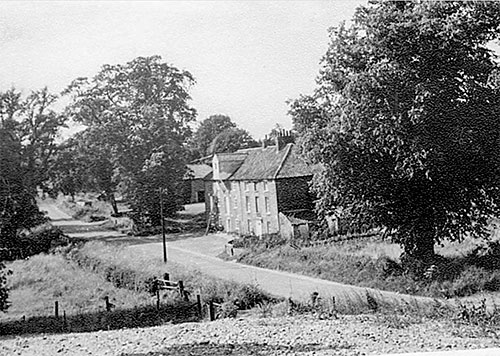 |
In those days on the way down to Hempstead mill there was a level crossing by the railway station in Holt. If you were lucky a train was coming and you had to stop, because the level crossing would be closed. The gates were operated from the signal box which was adjacent to the gates. The signal man looked out and turned a wheel from inside the box. All this has now vanished under the Holt bypass, except for the signal box itself; this was moved to Weybourne station where it replaced another signal box that had been demolished. Slightly further along the Hempstead Road was the Corona warehouse where the lorry was loaded up with bottles of ginger beer and lemonade for delivery to thirsty throats by the Corona man. The lorry was bright yellow and the bottles were stacked on the sides, angled inwards to prevent them spilling. Corona has disappeared long ago, but one of its brand names has remained and has indeed flourished; Tango. Continuing past the built up area of Holt and going down the hill to the river Glaven you first came to the pathway to the Holt Lowes. If you ignored this path you came to the mill. The water wheel was removed in the early years of the twentieth century and was replaced by a turbine (very up to date). By 1960, when I regularly visited it on my new red Palm Beach Raleigh bicycle, grain milling had ceased at the mill but a circular saw was still used for wood cutting. This stood out in the open, covered by a tarpaulin when not in use, but it was not behind any kind of shed. It was run by water power from the turbine. For me and my friends the main attraction was not so much the mill as the other side of the road, where the Lowes (or Holt Heath) spread out round the valley of the river Glaven. There, on the river banks, grew great bushes of rhododendrons in which we would make elaborate dens. Rhododendrons are ideal for making dens, and I had a lot of fun doing this, and so did my friend Robert George. Robert later forged a career in the Norfolk Police, ending up as the senior officer in the County Police Firearms Unit. I was not the first Gresham's schoolboy to play round the area of Hempstead milll; years before, the young W. H. Auden found it a congenial spot. He was already a budding poet, and although I do not know if he wrote any poems about Hempstead mill he certainly did about other local features. Slightly further up the river Glaven was Selbrigg pond , which was dug out two hundred years ago to provide additional head waters for Hempstead mill. When I mentioned this to my father at home it was assumed I was talking of Felbrigg , as no one had ever heard of Selbrigg. There is no village of Selbrigg, just a road of that name going to Bodham, the next village, so it not surprising that nobody has heard of it. In the spring of 1963 Selbrigg pond was frozen over like the rest of the countryside. This was during the Big Freeze. A Big Freeze it may have been by our standards, but the pond was not frozen so solid that you could walk all over it. Being foolish young children we enjoyed playing on the expanse of ice. How deep was it? I don't know but deep enough to be very dangerous. We could easily both have drowned. I was on the ice with another boy called Ward when it began to crack. I remained on the cracking ice but Ward fell into the freezing water. Luckily I was able to pull him out. He must have been very cold as we cycled back to school. Despite the cold weather we were wearing school uniform - shorts of course! All boys did in those days, even 14 year olds, and his were soaking wet as well. That was in my last term in the junior school; I don't remember going to Hempstead mill again. The senior school directed my attention more towards Kelling, Weybourne and the sea. The childish pleasures of making dens faded and the foolishness of playing on ice dawned in my consciousness. Robert George went into a different house from me, and my friendship with him waned as we made our separate ways into the adult world. Ward left the school entirely. Joseph Mason |
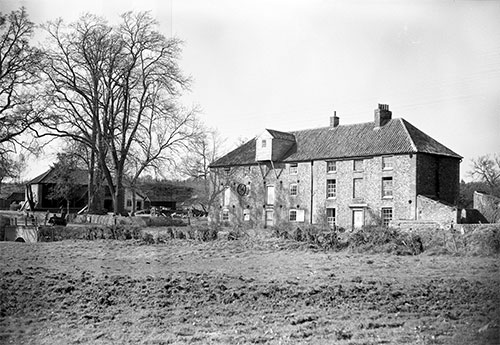 |
c.1955 |
|
When the wheel was removed and the turbine installed, the pitwheel was also taken out as the turbine provided drive in the same plane as the upright shaft. Although redundant, the wallower was left on the upright shaft. The turbine then drove the spur wheel directly by means of a cast iron gear. |
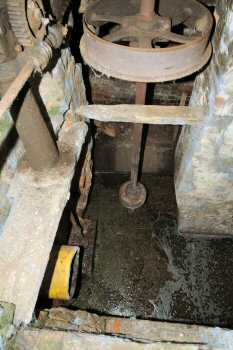 |
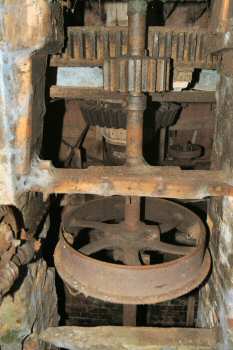 |
|
Turbine
pit 6th January 2004
|
Belt
and crownwheel drive January 2004 |
|
The mill machinery is now incapable of operating as one corner of the shaft support beam has sunk, preventing the turbine from disengaging. |
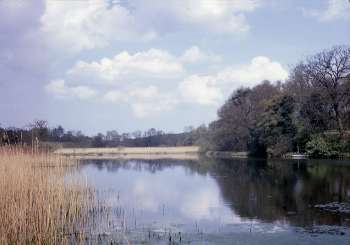 |
|
Mill
dam May 1967
|
|
W.H. Auden used to stay in the house next to the mill and would often visit the mill. |
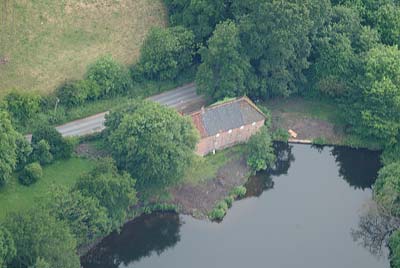 |
|
Rear
of mill 30th June 2004
|
|
The millpond originally
came right up to the back of the mill and the above photograph clearly
shows the filled in area. The River Glaven originally
ran to the left of the mill until the mill was built and the millpond was dug. |
| As a boy 1935 - 1945 I stayed with my grandparents at a cottage on the Norwich road about a mile out of Holt. Across Holt Heath, through the trees, I was able to see the light coloured lucum of a mill, which my grandfather said was Hempstead Mill. Basil Kybird, Drayton - 3rd March 2007 |
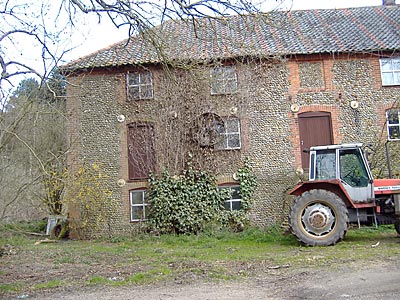 |
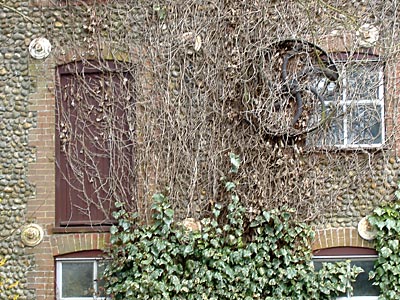 |
6th April 2008 |
Overgrown drive pulley 6th April 2008 |
The Newell family rented the mill house (the east section of the mill building) to Walter Platford and his wife Dot, from c.1946 to c.1960, after which, Walter moved to Stalham. |
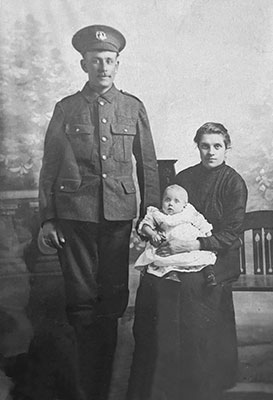 |
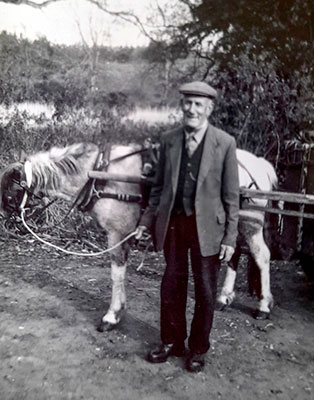 |
Mark & Bessie Platford |
Mark Platford with millpond behind - c.1952 |
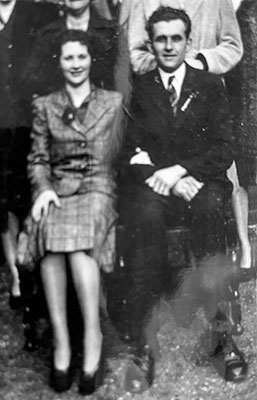 |
Dot and Walter Platford |
Walter Platford's brother Cyril, as a teenager, also lived at the cottage on the Hawksmere site. |
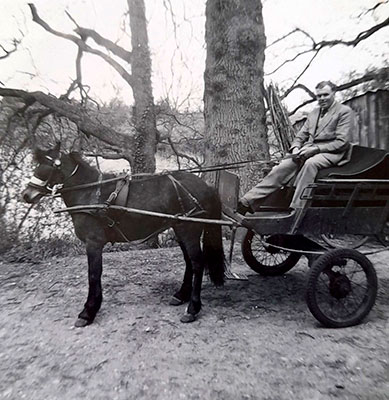 |
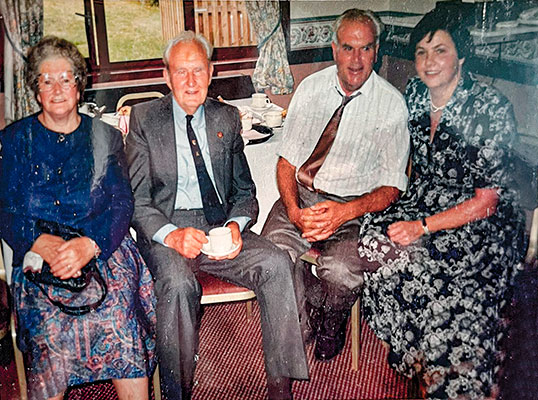 |
Cyril Platford with millpond behind - c.1955 |
Dot, Walter and Cyril Platford |
|
I am researching my family history. My wife's great, grandfather was a man called John William Elsy and he had a sister called Harriet Elizabeth. In 1875, Harriet married James Tuck, and, at the 1901 census, he is described as the "millers manager" at Watermill, Hempstead Road, HOLT. In 1911 he is "miller corn and coal merchant" at The Watermill. Brian Bartle - 14th February 2014 |
NEWALL PATRICK Suddenly in Holt on November 6th aged 76 years. Brother of Elizabeth and Mary, a dear uncle of Sarah, Gillian and Michael and great-uncle of Olivia and Imogen. A Thanksgiving service at St. Andrew's Church, Holt on Wednesday, December 3rd, 2014 at 2 p.m. will follow a private family cremation. Family flowers only please, donations, if desired payable to the British Heart Foundation c/o Lloyd Durham Funeral Services, Avenue Road, High Kelling, NR25 6RD.
|
I expect you will know that Patrick has died, late November 2014 I believe. There was a death notice in the paper and a Memorial Service was held at St Andrew's, Holt on 3rd December.
I do not know what is happening at the mill. To the best of my knowledge his sister Mary is dealing with his affairs. The mill is currently fenced off, or was when we visited just over a week ago. For what it is worth, there is some information about the family and the mill in Robin Carver's Hempstead, A Norfolk Village, a copy of which we read in Hempstead church. Bob Pendleton - 5th April 2015 |
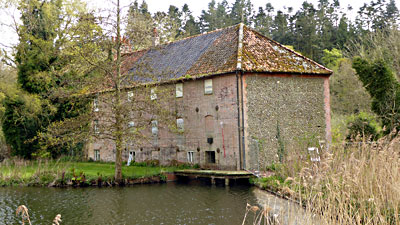 |
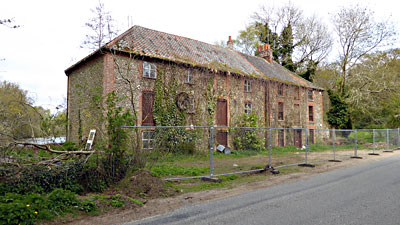 |
Mill rear 2nd May 2015 |
Mill fenced off 2nd May 2015 |
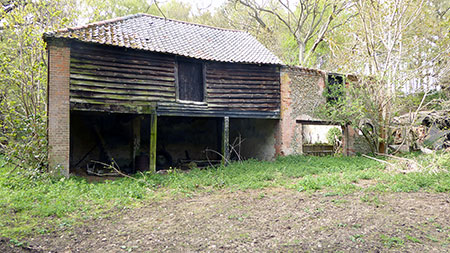 |
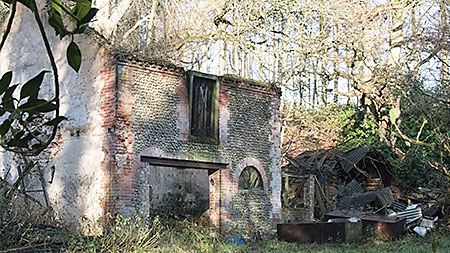 |
|
Mill bakery and outbuildings 2nd May 2015 |
Mill bakery 26th December 2017 |
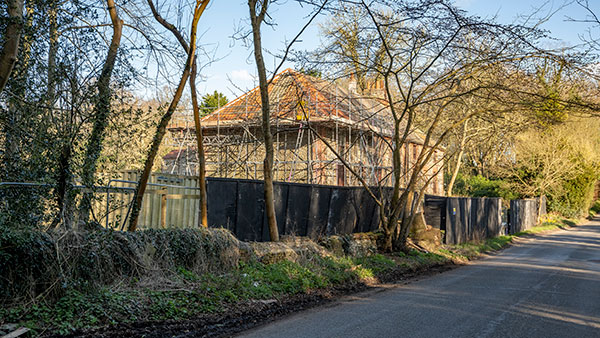 |
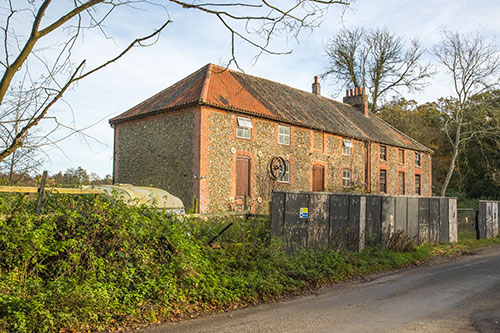 |
21st March 2020 |
18th November 2021 |
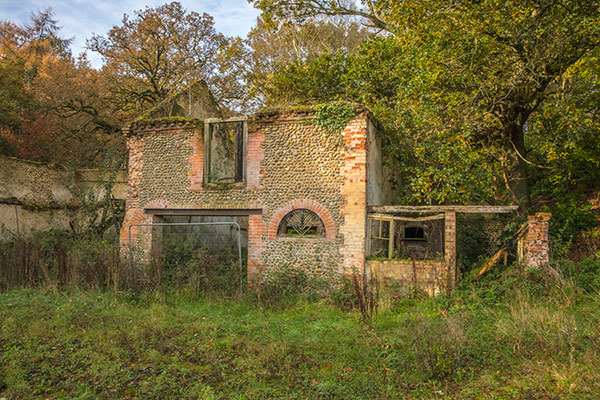 |
Bakehouse 18th November 2021 |
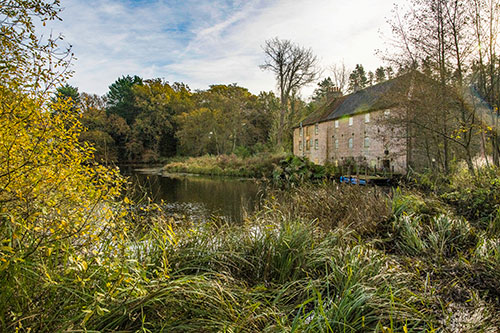 |
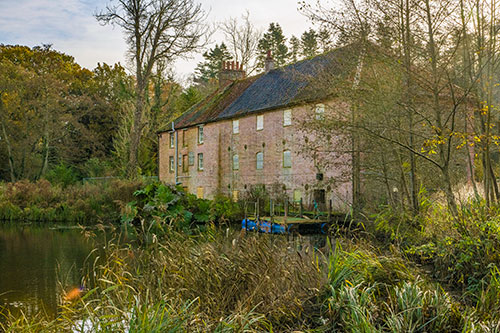 |
18th November 2021 |
|
On one of our school summer holidays the sluice gate at Hempstead Mill broke, the pit gang got there as soon as possible after hearing the news, it took three days for the mill pond to empty, There were every fish imaginable, many fish escaped by swimming down river with the water flow, we threw a 25 pound pike out of the river with our bare hands. Many fish died, we collected the dead fish and they became chicken feed. The next day the river authority came, they netted the river and stunned the fish enabling them to sort the fish and take them away in tanks and relocate them. After the sluice was repaired many of the fish were returned to the mill pond. When the Mill Pond emptied it separated into lots of little ponds, these were full of small fish unable to escape or be rescued because of the mud. All of the pit gang were naturally on site wanting to help. We at this stage were banned from the area as it was unsafe. We walked about two miles along the river to Long Sally’s, the river was alive with fish escaping. This was a sight never to be forgotten and seen only once in a lifetime. Chiffy the story teller - June 2023 |
During WW2, my brother Victor known to most as Mickey and his good friend Kenny Goldsmith, were given work cutting down trees from Long Sallys to Hempstead water mill, the wood was sawn, at the saw mill at the top of Holt Hill toward Hempstead. They also worked cutting trees in Holt Hall woods, the wood going to the same saw mill. There was a large sand pit at the bottom of Hempstead hill, opposite Hempstead water mill, at some time during WW2 the American soldiers made a camp there, and a dummy airfield at the top of Hempstead Hill. My brother Mickey and his friend Kenny cut down the trees around the side of Hempstead mill pond, they didn’t work at the weekends, when they went back to continue cutting trees on the Monday the American soldiers had used all the cut down trees to make rafts to use on the Mill Pond. My brother reported this to the American in charge, and was sent six helpers and two chain saws, something the hadn’t seen before. Needless to say the work became much easier, Mickey and Kenny just issued the work orders and watched the soldiers saw the trees down, two weeks work was achieved in two days. For the rest of the two weeks allocated to do the work, they spent most of the time in the naffi teaching the soldiers how to play darts. As children we used to go and see my brother working, the soldiers used to feed us, often they gave us a lift home, my brother Peter kept chickens and ducks and used to give the soldiers fresh eggs, in return they gave large tins of powered eggs, and sometimes butter which my mum used for cooking. But best all they gave us boys chocolate and chewing gum. Chiffy the story teller - June 2023 |
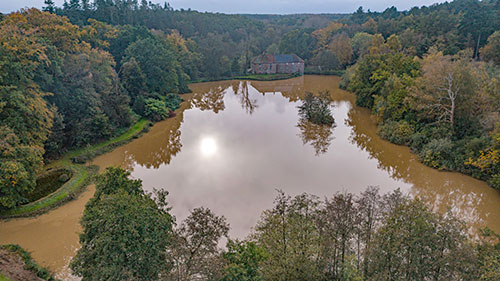 |
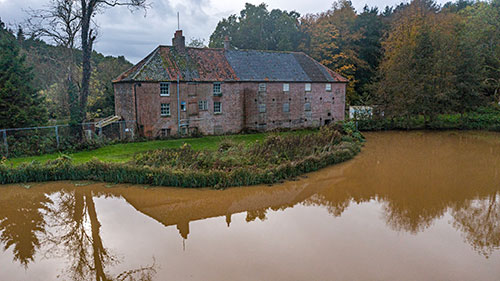 |
Mill and millpond - 29th October 2023 |
|
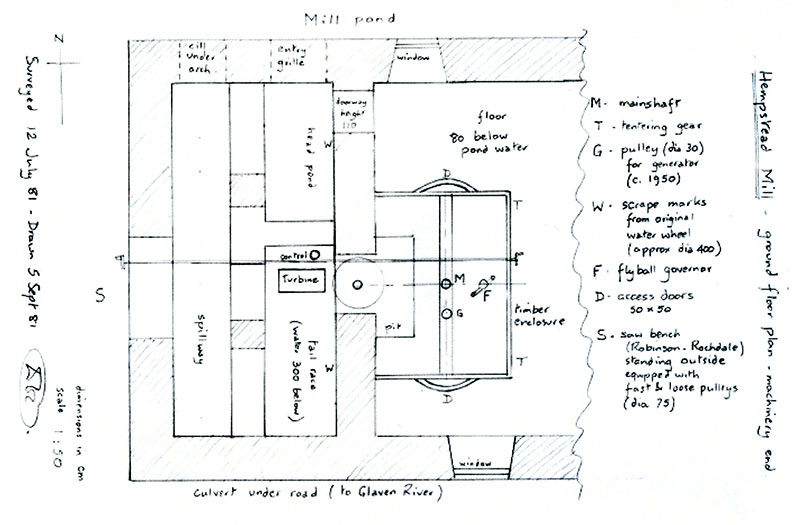 |
Hempstead ground floor plan surveyed and drawn by David Durst - 12th July 1981 |
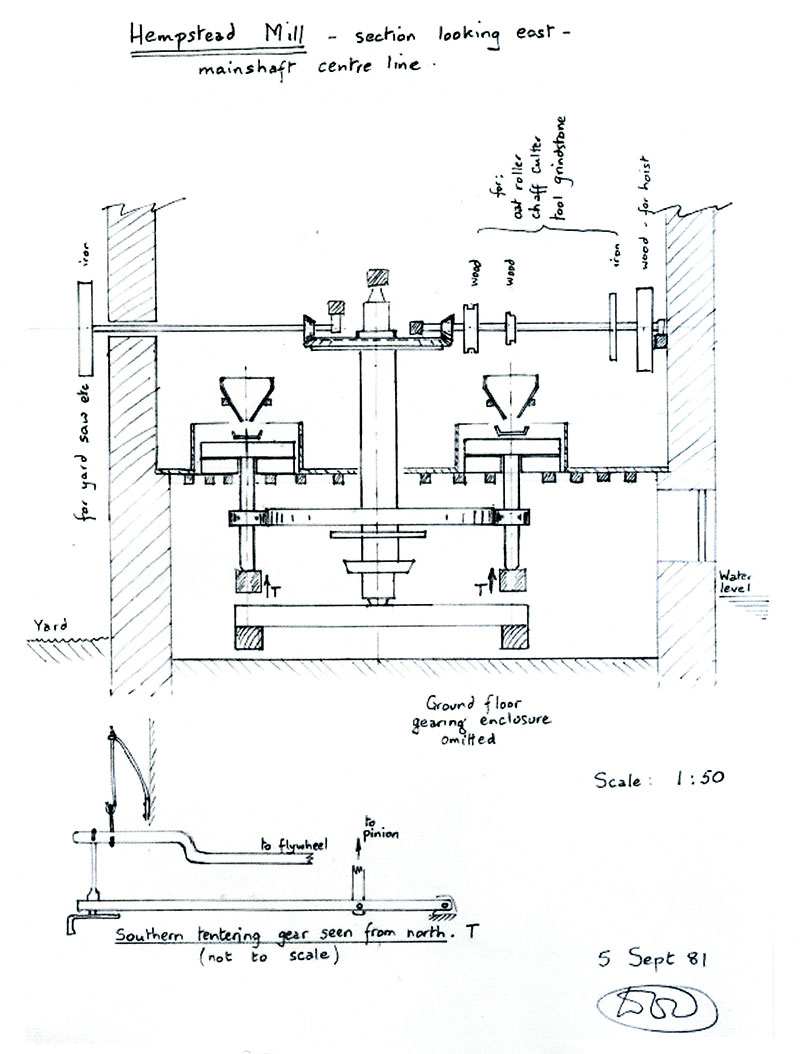 |
Hempstead gearing surveyed and drawn by David Durst - 5th September 1981 |
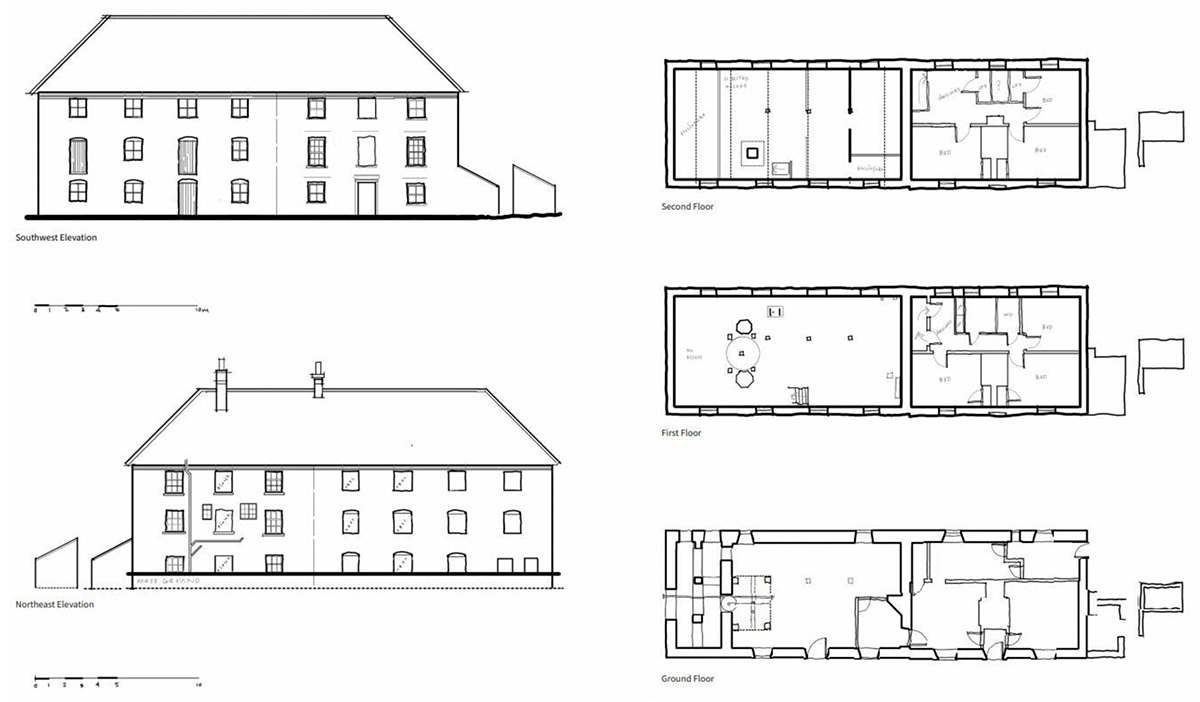 |
Hempstead plan drawings from Rightmove sale website - August 2023 |
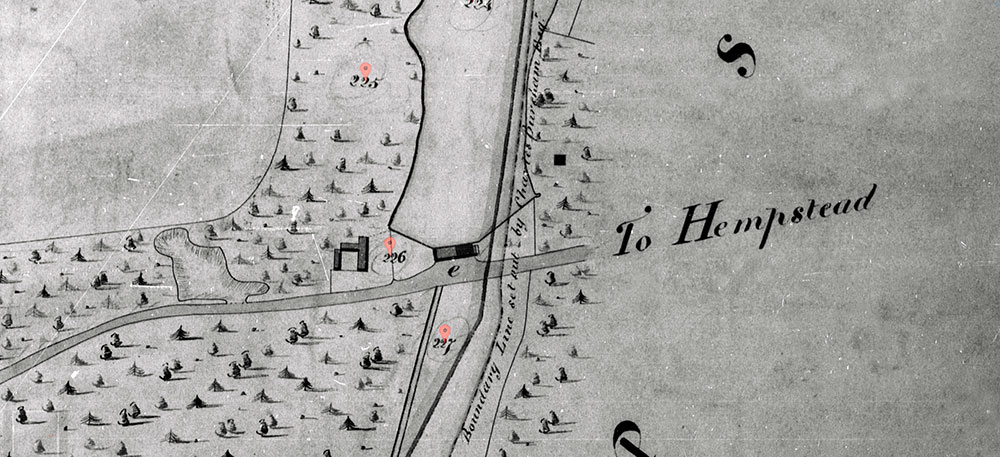 |
Tithe map 1839 |
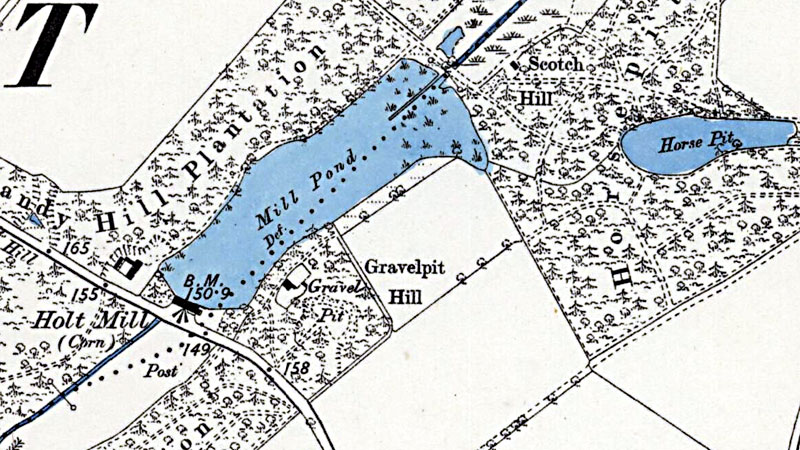 |
O. S. 6" Map 1885 |
The dotted old boundary line clearly shows the original course of the River Glaven before it was diverted to the northwest in order to accommodate the mill. |
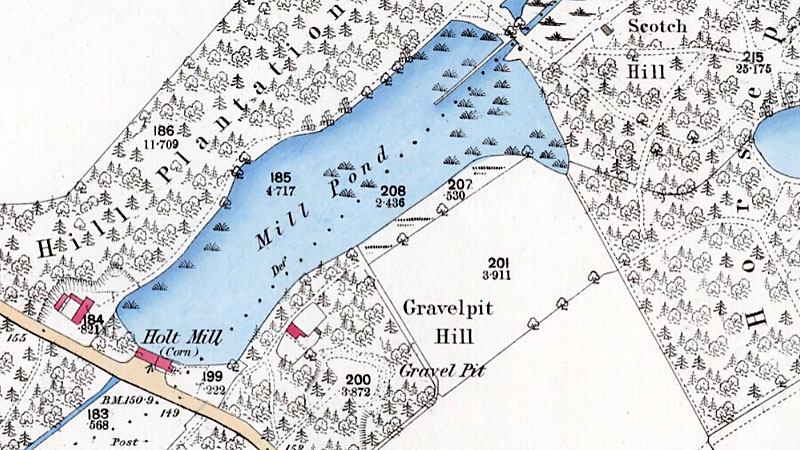 |
O. S. 25" Map 1885 |
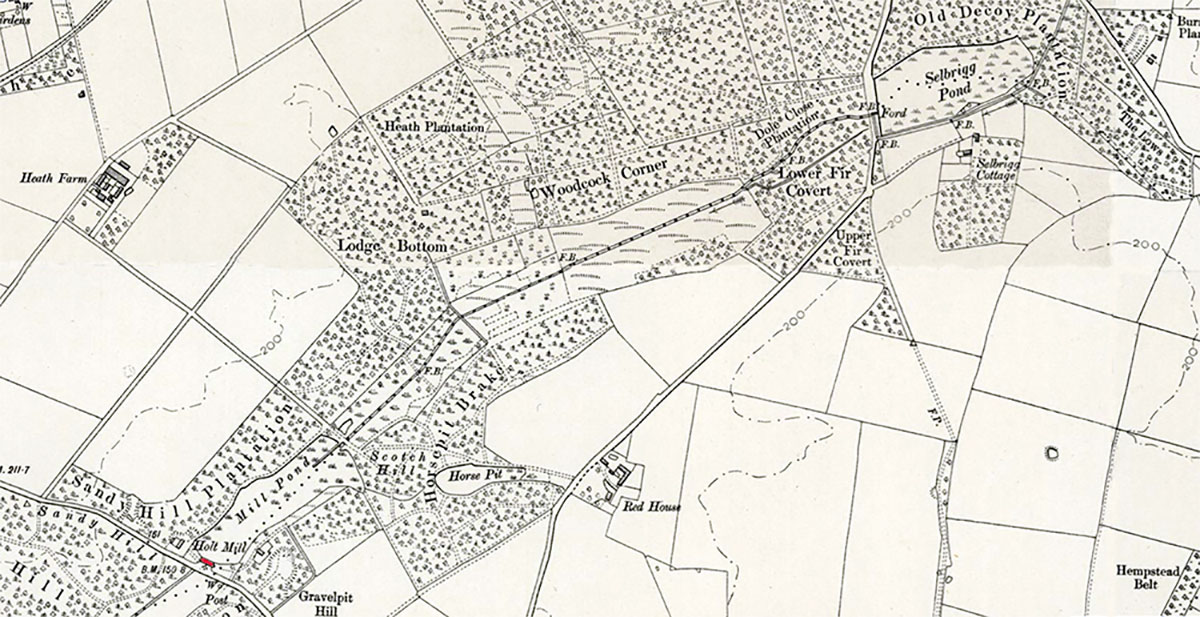 |
O. S. 6" Map 1905 |
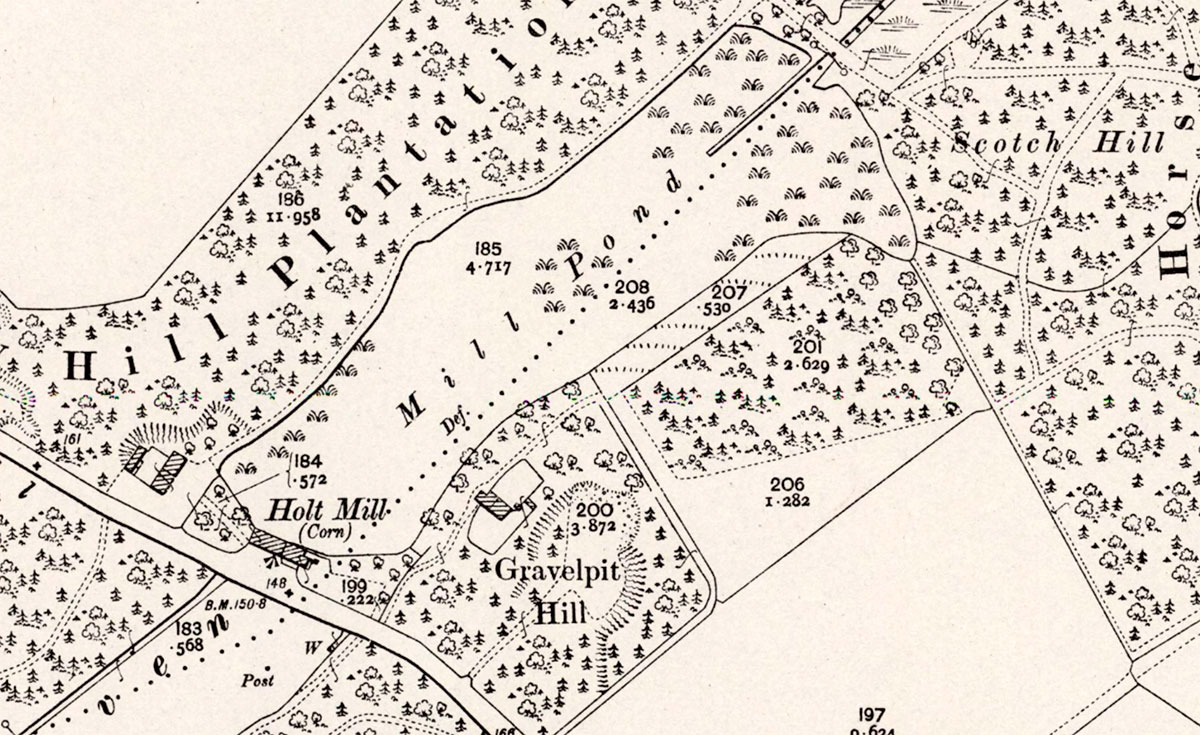 |
O. S. 25" Map 1905 |
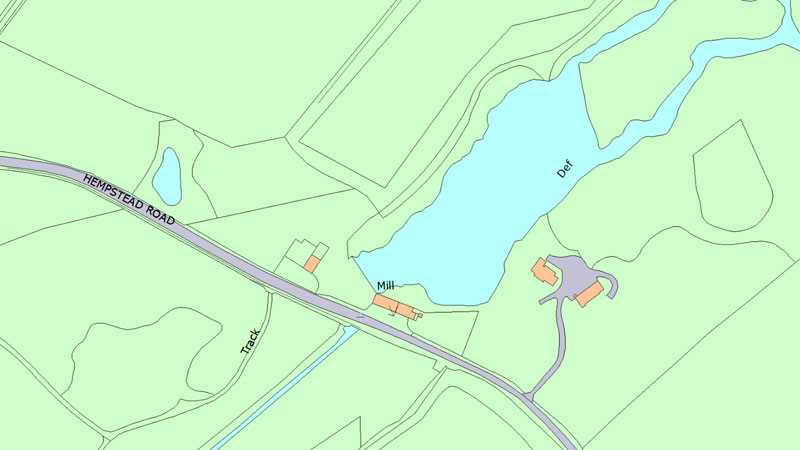 |
O. S. 25" Map November 2023 |
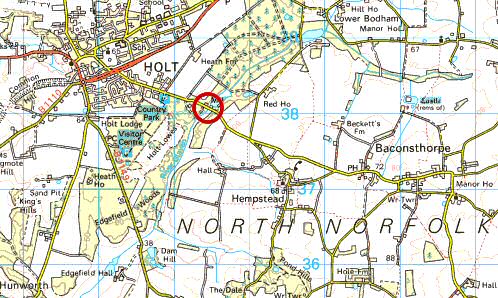 |
O.S. Map 2005 Image reproduced under licence from Ordnance Survey |
|
c.1810: Mill built and Selbrigg Pond dug by hand to provide a water supply from the River Glaven
1872: Frederick W. Harris, miller 1907: John Tuck - last miller to grind flour for bread made on the premises
and also coal merchant c.1911 - 1912: Thomas John Preston - gave up shortly after the 1912 flood that
swept away the upper pond
1970s:
The turbine powered circular saw was still running as late as 1977 2004: Mill
occupied by Pat Newell, son of Frank Newell |
If you have any memories, anecdotes or photos please let us know and we may be able to use them to update the site. By all means telephone 07836 675369 or
|
| Nat Grid Ref TG 09463806 | Copyright © Jonathan Neville 2023 |